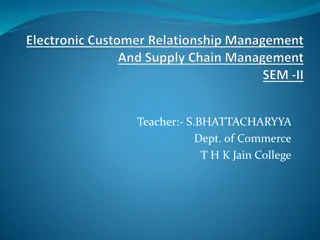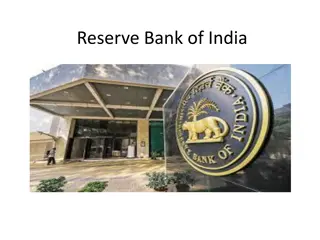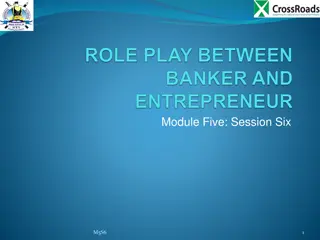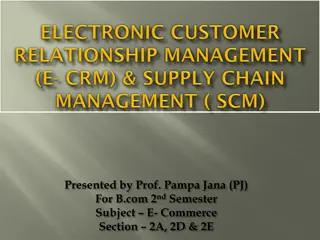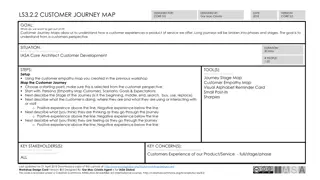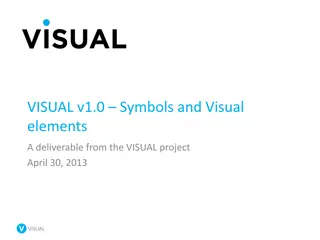Understanding the Banker-Customer Relationship
The relationship between a banker and a customer is defined by the provision of banking services such as fund transfers and cheque issuance. It is primarily a debtor-creditor relationship but also involves trust, agency, bailment, mortgage, and leasing aspects. Regulations are governed by laws like the Negotiable Instruments Act and the Indian Contract Act. Both parties have certain rights and duties, even though the contract is not always in written form.
Download Presentation

Please find below an Image/Link to download the presentation.
The content on the website is provided AS IS for your information and personal use only. It may not be sold, licensed, or shared on other websites without obtaining consent from the author. Download presentation by click this link. If you encounter any issues during the download, it is possible that the publisher has removed the file from their server.
E N D
Presentation Transcript
RELATIONSHIP BETWEEN RELATIONSHIP BETWEEN BANKER AND CUSTOMER BANKER AND CUSTOMER Dr.A.Antonyraj Assistant Professor Department of Management studies, Bon Secours College for women, Thanjavur.
Definition of Bank Definition of Bank Section 5(b) of the Banking Regulation Act,1949 defines banking as accepting, for the purpose of lending and investment, of deposits of money from the public, repayable on demand or otherwise and withdrawable by cheque, draft, order or otherwise. Definition of Banker Definition of Banker Halsbury s Laws of Englanddefines, A Banker is an individual, partnership or corporation, whose sole or predominating business is banking, that is the receipt of money on current or deposit account and the payment of cheques drawn by and the collection of cheques paid in by customer. Customer Customer The term customer is also not defined in any of the statutes. A person becomes a customer of a bank when the bank agrees to open an account of the customer. Thus a customer is a person who has some sort of account with a banker.
BANKER BANKER- -CUSTOMER RELATIONSHIP CUSTOMER RELATIONSHIP According to John Paget s Law of Banking The essence of the relationship of banker and customer is the affording of the facility to the customer to draw funds from the bank by issuing cheques. This is the primary characteristic of a banking business. Without it the business is not banking as known and understood in the English Law . The relationship between a banker and his customer is basically the contractual relationship of debtor and creditor. The term of contract do not exist in any written form but it based on mutual consent. Yet it is regulated by the provisions of the Negotiable Instruments Act, 1881 and the Indian Contract Act,1872 . Though at the time of opening account, certain rules are followed, yet the procedure does not mentioned comprehensively the rights and duties of the banker or the customer.
Features of Banker-Customer Relationship Bank as the debtor, the customer being the creditor; Bank as the trustee, the customer being the beneficiary of the trust; Bank as the agent, to do certain acts for and on behalf of the customer who stands in the position of a principal in the relationship; Bank as the bailee, in respect of papers, documents, title deeds, etc., filed by the customer, pledge or hypothecation of stock in trade for obtaining short and long term loans. The customer stands as a bailor of such articles; Bank as the mortgagee, of properties mortgaged to the bank by way of security for loans, bank guarantees, etc., Bank as the lessee, the bank lets out lockers to customers and in that relationship it become a lesser and in respect of the articles stored by a customer in his locker, the bank to a certain extent becomes a bailee, though not in the typical sense of the word because those articles are not put in the exclusive control of the bank; Residuary functions of many a kind are performed by banker in accordance with their banking practices.
DUTIES OF THE BANKER DUTIES OF THE BANKER Duty to honour customers cheques. It is the contractual obligation of the banker to honour his customer s cheque as long as he has sufficient balance to his credit applicable to the payment of the cheque. An unjustified dishonour is not merely a breach of contract, but also a tort as it damages the customer s reputation. Thus, the banker s obligation to honour the customer s cheque depends entirely on the contract between the banker and customer. Duty to verify cheque in electronic image. The who receives payment on the basis of the electronic image of a truncated cheque which is held by him, is under a duty to verify the prima facie genuineness of the cheque to be truncated. Duty to supply account statements. Many bank in the wake of modernization, have dispensed with the system of passbooks. It was the customer s duty have his passbook updated. But now the banks have adopted the practices of sending to their customers periodical statements of their accounts. Hence, it is the banker s duty to assure the correctness of statement and its timely dispatch to the customer. Duty of confidentiality. The contract between banker and customer is of confidential nature. A bank is under a duty of secrecy so far as the customer s dealing with him are concerned and would liable in damages if any loss is caused to the customer by leakage of secret information.
RIGHTS OF THE BANKER RIGHTS OF THE BANKER General lien[s.171]. A banker has a general lien on all bills received from a customer in the ordinary course of banking business in respect of any balance that may be due from such customer. Incidental charges and interest. The banker has the right to claim from the customer incidental charges and interest on money lent to the customer as per the rules and regulations communicated to him at the time when account is opened. Right to set off. Where the banker has two account of the customer, one showing a credit balance and the other is debit balance, the banker has the right to combine the two accounts and set off the balance of one against the other. Right of appropriation. A banker has the right to appropriate payments of the customers.
When may a banker dishonour a customers cheque ? A banker may dishonour a customer s cheque in following cases: Where the banker does not have sufficient funds to the credit of the customer. Where the funds to the credit of the customer are not applicable to the payment of the cheque, e.g., when the money is held in trust. Where the cheque is ambiguous or of doubtful legality. Where the cheque is mutilated. Where the cheque materially altered. Where the cheque is not duly presented. Where the customer s signature does not agree with his specimen signatures. Where the cheque has become stale. Where the cheque is post dated. Where an account is in joint names of a few persons, but they have not all signed the cheque.
When must a banker dishonour a customers cheque A banker must dishonour a customer s cheque in the following cases ? When the customer countermands payment. When the banker receives notice of the customer s insanity. When the banker receives the notice of the customer s death. But if he pays a cheque before he receive notice, the payment is valid. When the customer gives notice to the banker to close the account. When the customer gives the notice of assignment of the credit balance of his account. When the holder gives a notice of loss of a cheque to the banker. The banker may, however, insist that the holder should obtain a countermand from the drawer.
Paying Banker and Collecting Banker Paying Banker and Collecting Banker When a cheque is a crossed cheque, then the payment of such crossed cheque is not paid to the customer at the counter of the bank. Instead, when a customer presents a crossed cheque to a bank, then it is the duty of the bank to credit the amount of the cheque into the account of the customer. Paying Banker.The bank who makes the payment of a crossed cheque is called the paying banker. Collecting Banker.The bank which receives the payment of a crossed cheque on behalf of his customer is called as collecting banker.
Duty of A Paying Banker Duty of A Paying Banker Payment of a cheque crossed generally (Section-126):-It is the duty of the paying banker to pay a generally crossed cheque only to another banker. Payment of a cheque crossed specially (section-126):- When a cheque has been crossed specially, it is the duty of the paying banker to pay such a cheque only to the bank to whom it has been crossed. Another duty of the paying banker is stated in Section 127. Where a cheque is crossed specially to more than one banker, except when necessary for collection, the banker on whom it is drawn should refuse payment.
PROTECTION TO THE PAYING BANKER PROTECTION TO THE PAYING BANKER Protection u/s128.According to section 128 when the paying bank, i.e., that bank whom the crossed cheque is drawn makes the payment of the cheque in due course it is deemed to be a valid payment as if the payment had been received by the true owner of the cheque. But u/s129, if payment of crossed cheque is made out of due course:- paying banker is liable for the losses suffered by the true owner of the cheque. Protection u/s89. When a cheque does not at the time of presentment appear to be crossed or where the crossing is obliterated, the banker, paying the cheque in good faith and without negligence, will be discharged from his liability on the cheque. This section covers two issues:- When in an order cheque, payee s indorsement is forged. When there was an order cheque, which was indorsed by forgery of payee s signature and the bank makes the payment for such a cheque. When the payment of a bearer cheque is made to a bearer. When the bearer cheque is paid to the bearer by the bank in due course, ignoring the fact that the cheque was indorsed at the back of it, or the indorsement restricted further negotiation of the cheque, the bank is said to be discharged.
Protection to the collecting Banker Protection to the collecting Banker A banker who has in good faith and without negligence received payment for a customer of a cheque crossed generally or specially to himself shall not, in case the title to the cheque proves defective, incur any liability to the true owner of the cheque by reason only of having received such payment. Under section 131 The requirement of this protection u/s131 are as follow: Payment should have been received for customer. The bank should collect or receive payment of the crossed cheque as an agent on behalf of the customer. It should be a crossed cheque. The banker must receive the payment as a crossed cheque. It means that the cheque which is to be collected must have been given to the banker as crossed i.e., which was crossed either generally or specially to that banker before it reached the hands of the collecting bank.
Good faith and without negligence. The collecting bank must have acted in good faith and without negligence in collecting the amount due on the cheque. If the bank fails to make any such inquiry, he is not acting in good faith. Truncated cheque. It shall be the duty of the banker who receive the payment based on an electronic image of a truncated cheque held with him, to verify the prima facie genuineness of the cheque to be truncated and nay fraud, forgery or tampering apparent on the face of instrument that can be verified with due diligence and ordinary care.



